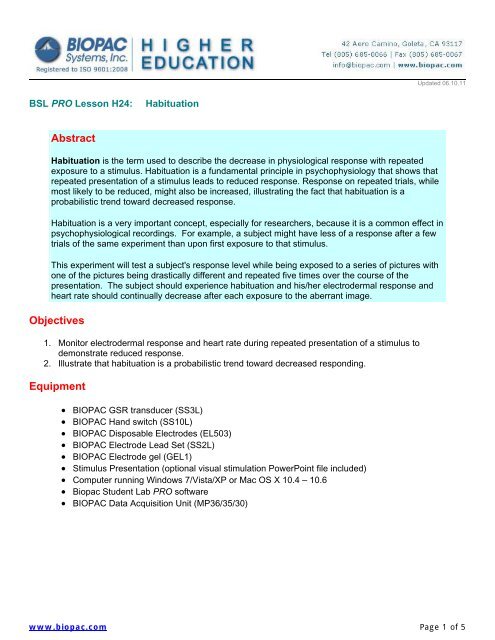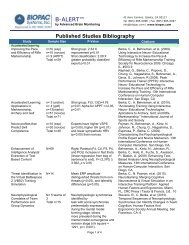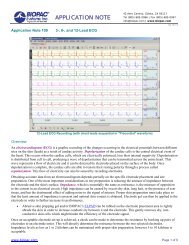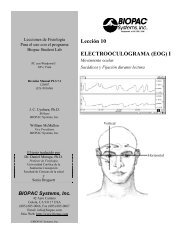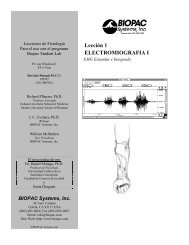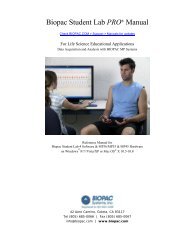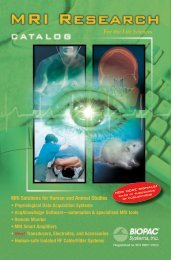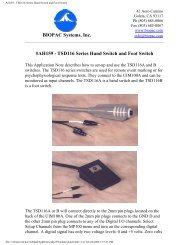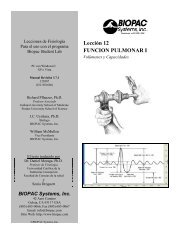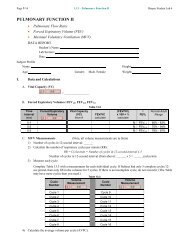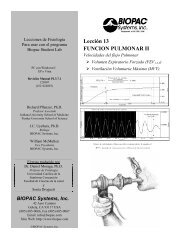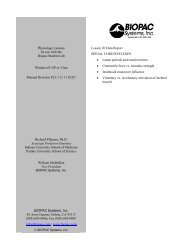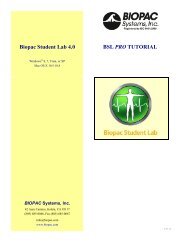BSL PRO Lesson H24 - Biopac
BSL PRO Lesson H24 - Biopac
BSL PRO Lesson H24 - Biopac
Create successful ePaper yourself
Turn your PDF publications into a flip-book with our unique Google optimized e-Paper software.
Updated 06.10.11<br />
<strong>BSL</strong> <strong>PRO</strong> <strong>Lesson</strong> <strong>H24</strong>:<br />
Habituation<br />
Abstract<br />
Habituation is the term used to describe the decrease in physiological response with repeated<br />
exposure to a stimulus. Habituation is a fundamental principle in psychophysiology that shows that<br />
repeated presentation of a stimulus leads to reduced response. Response on repeated trials, while<br />
most likely to be reduced, might also be increased, illustrating the fact that habituation is a<br />
probabilistic trend toward decreased response.<br />
Habituation is a very important concept, especially for researchers, because it is a common effect in<br />
psychophysiological recordings. For example, a subject might have less of a response after a few<br />
trials of the same experiment than upon first exposure to that stimulus.<br />
This experiment will test a subject's response level while being exposed to a series of pictures with<br />
one of the pictures being drastically different and repeated five times over the course of the<br />
presentation. The subject should experience habituation and his/her electrodermal response and<br />
heart rate should continually decrease after each exposure to the aberrant image.<br />
Objectives<br />
1. Monitor electrodermal response and heart rate during repeated presentation of a stimulus to<br />
demonstrate reduced response.<br />
2. Illustrate that habituation is a probabilistic trend toward decreased responding.<br />
Equipment<br />
BIOPAC GSR transducer (SS3L)<br />
BIOPAC Hand switch (SS10L)<br />
BIOPAC Disposable Electrodes (EL503)<br />
BIOPAC Electrode Lead Set (SS2L)<br />
BIOPAC Electrode gel (GEL1)<br />
Stimulus Presentation (optional visual stimulation PowerPoint file included)<br />
Computer running Windows 7/Vista/XP or Mac OS X 10.4 – 10.6<br />
<strong>Biopac</strong> Student Lab <strong>PRO</strong> software<br />
BIOPAC Data Acquisition Unit (MP36/35/30)<br />
www.biopac.com Page 1 of 5
<strong>BSL</strong> <strong>PRO</strong> <strong>Lesson</strong> <strong>H24</strong><br />
Setup<br />
BIOPAC Systems, Inc.<br />
Hardware<br />
1. Plug the GSR transducer into CH 1 on the MP3X unit.<br />
2. Plug electrode lead set into CH 2<br />
3. Plug the hand switch into CH 3 on the MP3X unit.<br />
4. Turn on the MP3X data acquisition unit.<br />
Software<br />
1. Turn on the computer.<br />
2. Launch the <strong>BSL</strong> <strong>PRO</strong> software on the host computer.<br />
3. Open the Habituation lab by choosing File menu > Open > choose Files of type: GraphTemplate<br />
(*GTL) > File Name: <strong>H24</strong> Habituation.gtl.<br />
In <strong>BSL</strong> 3.7.7 and higher, the template can be selected in the Startup Wizard by selecting ‘Record a lesson ><br />
<strong>BSL</strong> <strong>PRO</strong>’ and choosing <strong>H24</strong> from the list.<br />
Subject<br />
GSR Setup<br />
• The template can also be downloaded from the BIOPAC website <strong>PRO</strong> <strong>Lesson</strong>s page.<br />
1. Fill both cavities of the GSR transducer with gel.<br />
2. Attach the transducer to the Subject’s favored hand as<br />
shown, one band on the middle finger and the other on<br />
the index finger.<br />
www.biopac.com Page 2 of 5
<strong>BSL</strong> <strong>PRO</strong> <strong>Lesson</strong> <strong>H24</strong><br />
ECG Setup<br />
BIOPAC Systems, Inc.<br />
1. Place electrodes on the inside of the right wrist and on<br />
inside of both ankles, above ankle bone.<br />
2. Place electrode leads as shown in diagram.<br />
Red - Left ankle<br />
Black (GND) - Right ankle<br />
White - Right Wrist<br />
Running the Experiment<br />
The template is set to display CH 1 GSR, CH 3 Hand switch, and CH 40 Heart Rate. Heart rate is calculated<br />
from the ECG signal, but the CH 2 ECG signal is hidden.<br />
Recorder will press the hand switch to mark when the aberrant picture appears.<br />
Hints for minimizing data error<br />
<br />
<br />
<br />
<br />
<br />
<br />
Wait at least five minutes after attaching the GSR transducer and electrodes so the skin has ample time<br />
to absorb the gel.<br />
For best results, subject should not move and recording should not be stopped between calibration and<br />
the experiment segments.<br />
The subject must avoid excessive extraneous movement.<br />
Press the hand switch every time the clown picture appears (to be used as a time marker).<br />
Remove all jewelry or other metal objects.<br />
Check all cable connections.<br />
Signal Check<br />
1. Position subject approximately 2 feet directly in<br />
front of computer monitor.<br />
2. Click “Start” to begin recording.<br />
3. Have the subject inhale deeply.<br />
4. Review the data after 10-15 seconds, while<br />
continuing to record.<br />
• If CH 1 GSR displays a significant<br />
change, as shown at right, continue<br />
without stopping the recording. If not,<br />
check all connections and repeat.<br />
www.biopac.com Page 3 of 5
<strong>BSL</strong> <strong>PRO</strong> <strong>Lesson</strong> <strong>H24</strong><br />
Experiment<br />
BIOPAC Systems, Inc.<br />
Note<br />
This experiment uses a PowerPoint presentation for visual stimulation, but you may use any repeated<br />
stimulus with one or more aberrations.<br />
1. If calibration was successful, continue the recording.<br />
2. Have the subject relax until GSR is stabilized and there is a constant straight line.<br />
• Note: At this point subject should already be sitting in front of monitor, and should be relaxed and<br />
not moving.<br />
3. Once the subject is set, open the <strong>H24</strong> PowerPoint presentation.<br />
• When the slideshow is open, the BIOPAC screen will not be visible.<br />
4. Click F5 to begin playing the slideshow (or select View Show from the Slide Show menu).<br />
• Hit the “Esc” key to stop the slide show at any time.<br />
5. Recorder must use the hand switch to indicate when the aberrant picture is presented.<br />
6. At the end of the slideshow, close PowerPoint.<br />
7. Click Stop to end the recording.<br />
www.biopac.com Page 4 of 5
<strong>BSL</strong> <strong>PRO</strong> <strong>Lesson</strong> <strong>H24</strong><br />
Data Analysis<br />
BIOPAC Systems, Inc.<br />
You can measure the GSR change on repeated trials, which will likely reduce with each repetition.<br />
Standard Trial Habituation Data Using the <strong>BSL</strong> <strong>PRO</strong><br />
Appendix<br />
GRAPH TEMPLATE SETTINGS<br />
Click here to open a PDF of the graph template file settings. The <strong>BSL</strong> <strong>PRO</strong> Graph Template file automatically<br />
establishes the settings shown in the table.<br />
www.biopac.com<br />
Page 5 of 5


